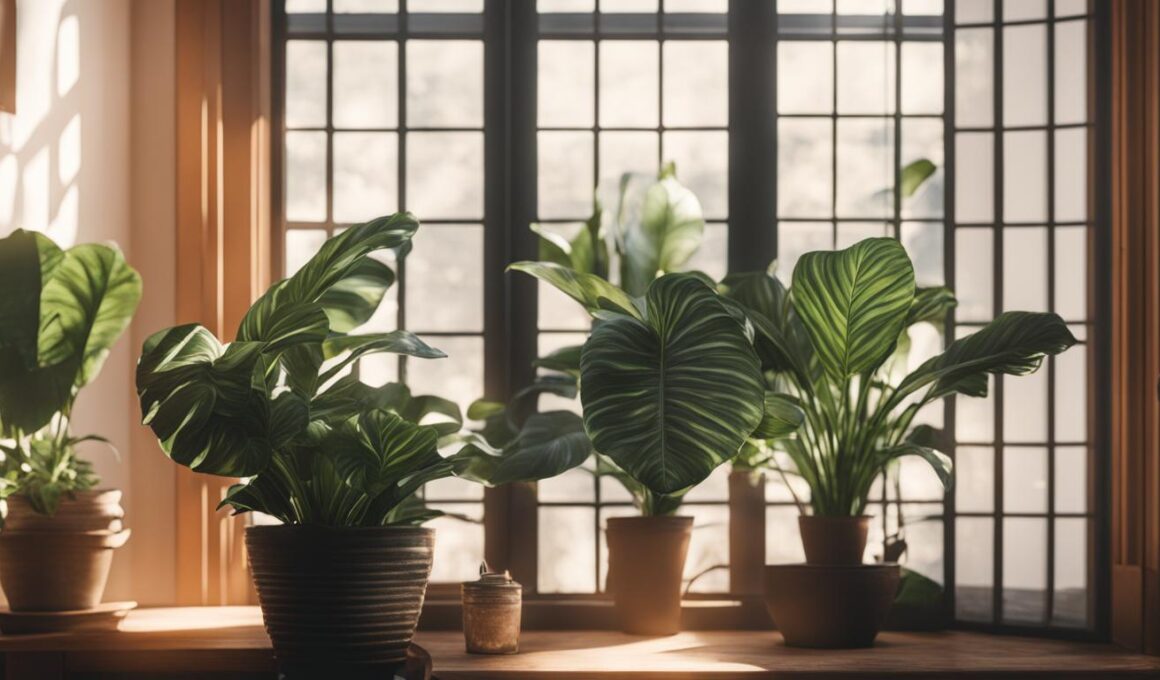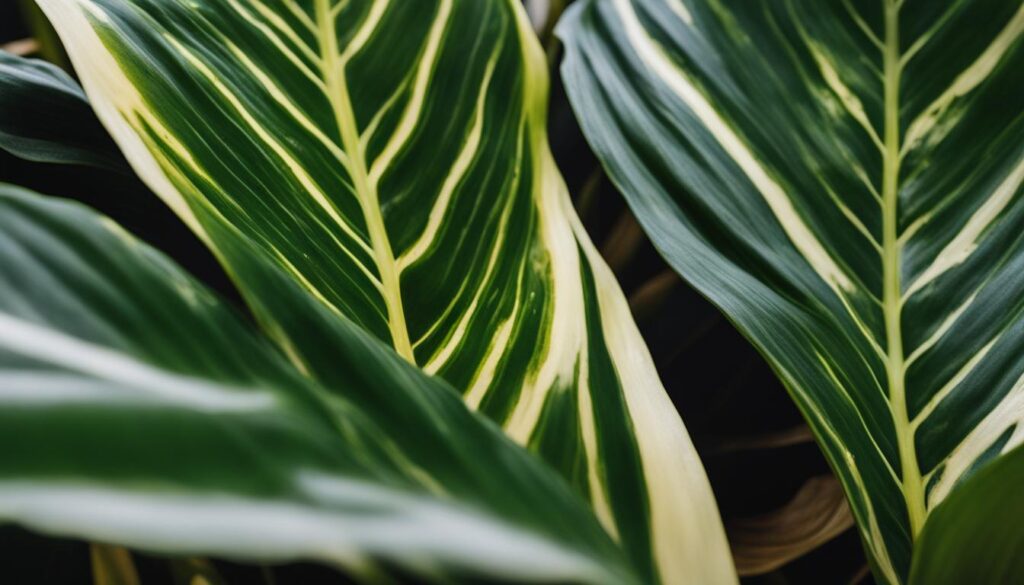When it comes to Calathea plant care, understanding the role of optimal sunlight is essential for promoting healthy Calathea growth and maintaining their stunning foliage. These popular houseplants, native to tropical regions, thrive in medium to bright indirect sunlight, making them one of the most versatile indoor lighting choices for plants for low light environments. Through strategic placement, consistent watering, and the right temperature, humidity levels, your Calathea plants can grow to become a show-stopping focal point in your home. In this article, you’ll discover practical tips for creating the perfect living conditions for your Calathea plants.
Key Takeaways
- Calatheas require medium to bright indirect sunlight for optimal growth and health.
- Direct sunlight can cause fading and burning on the leaves, leading to irreversible damage.
- Each Calathea species may have slightly different sunlight preferences, but most can adapt to low light conditions.
- Strategic positioning and artificial light sources can help satisfy Calatheas’ indirect sunlight needs.
- Apart from sunlight, proper watering, humidity, and temperature are also crucial for successful Calathea care.
Understanding Calathea Light Requirements
Calathea indoor plants are renowned for their striking foliage and intricate patterns. Ensuring adequate lighting conditions for your Calathea is essential to maintain its unique appearance and health. In this section, we delve into the details of Calathea light requirements, explain how to provide optimum conditions, and discuss how these needs can vary by species.
It’s crucial to understand that Calatheas do best in low to bright indirect sunlight. Direct sunlight can cause their vivid leaves to fade, bleach, or burn. Since all Calathea species are low light houseplants, they can adapt well to less than optimal lighting conditions, while exhibiting their trademark leaf movements. Nonetheless, different Calathea species have varied preferences when it comes to the ideal amount of light they require.
| Calathea Species | Preferred Light Conditions |
|---|---|
| Calathea ornata (Pinstripe) | Low to medium indirect light |
| Calathea medallion | Medium to bright indirect light |
| Calathea orbifolia | Bright indirect light |
| Calathea lancifolia (Rattlesnake Plant) | Medium indirect light |
For instance, while most Calathea species thrive in medium to bright indirect light, others with darker foliage, like Calathea ornata, can prosper even in lower light settings. Knowing your specific Calathea’s light requirements will help you create the perfect environment for it to flourish.
When positioning your Calathea indoors, choose a spot where it can receive indirect sunlight throughout the day. Here are some tips to ensure the right lighting conditions for your Calathea:
- Place your Calathea near a window with filtered or diffused light, such as a north-facing window or a window with sheer curtains.
- Avoid exposing your plant to direct sunlight, as this can cause damage to its delicate leaves.
- Monitor your Calathea’s growth and adjust its location as needed to ensure it receives adequate light consistently.
By providing the right balance of indirect sunlight, you can keep your Calathea healthy and maintain its stunning foliage, ensuring it remains a visually appealing addition to your indoor space.
Types of Calathea and Their Sunlight Preferences
Among the plethora of houseplant varieties, different types of Calathea have varying indoor sunlight preferences. Understanding the unique requirements of each type will help you provide delicate plant care and maintain their vibrant, intricately patterned leaves.
Calathea Medallion and Its Vibrant Patterns
The eye-catching Calathea Medallion boasts a beautiful display of vibrant patterns that rely on proper lighting to maintain their aesthetic appeal. Like all Calatheas, the Medallion requires indirect sunlight to keep the intricate designs on its foliage in peak condition. A medium to bright indirect light setting promotes the health and vibrancy of the Medallion’s patterns while preventing the potential threats posed by harsh direct sunlight.
The Delicate Needs of Calathea Orbs and Pinstripes
Other popular Calathea varieties include Calathea Orbifolia and Calathea Pinstripe. These plants are known for their particularly delicate nature, requiring precise attention to their sunlight needs. To preserve their distinct leaf patterns and colors, it’s essential to place these varieties in environments that offer an optimal balance of light. Indirect, diffused light is preferable to ensure the beautiful details of their leaves remain crisp and eye-catching.
To help you care for your Calatheas, here are some practical tips on managing the sunlight preferences of Calathea Orbifolia and Calathea Pinstripe:
- Place them near a window that receives dappled sunlight or bright shade.
- Avoid placing them near a south-facing window or in direct sun; instead, opt for a north-facing or east-facing window.
- Use sheer curtains or blinds to diffuse the sunlight coming through the window.
- Rotate the plants periodically to ensure even light exposure and prevent uneven growth.
By catering to the sunlight needs of your Calathea plants, you will provide a suitable environment for these amazing houseplants to thrive and showcase their intricate, colorful patterns.
Spotting Sunlight-Related Stress in Calatheas
Calatheas are prone to various forms of sunlight stress, which can manifest in several ways. Identifying these signs early can help you take preventive measures and adjust your Calathea care routine accordingly. To better recognize sunlight stress symptoms, consider the following common indicators:
- Yellowing leaves
- Burnt leaf tips
- Limping and drooping leaves
These symptoms often indicate damage from direct sunlight or inadequate watering, both of which compromise your Calathea’s health. To prevent and address these issues, adhere to the following care tips:
- Protect from direct sunlight: Ensure that Calatheas are kept out of direct light. Their natural habitat consists of dappled sunlight filtering through the forest canopy, so they prefer indirect light exposure in a home setting.
- Maintain soil moisture: Consistently monitor the moisture levels in the soil, making sure it doesn’t become too dry or overly saturated. Calatheas thrive best with evenly moist soil, so maintaining the proper balance is essential.
- Monitor humidity: Calatheas flourish in high humidity environments, similar to their native tropical habitats. Aim for humidity levels above 50% for optimal growth and health.
| Sign | Description | Cause | Solution |
|---|---|---|---|
| Yellowing leaves | Leaf color turning yellow or pale | Direct sunlight exposure or inadequate watering | Move the plant to a shadier location and adjust watering schedule |
| Burnt leaf tips | Brown or blackened leaf tips | Excessive direct sunlight or lack of humidity | Provide indirect sunlight and increase humidity levels |
| Limping and drooping leaves | Leaves lose their firmness and hang down | Prolonged exposure to direct sunlight or insufficient watering | Place the plant in indirect light and adjust watering accordingly |
By closely monitoring your Calathea’s condition and being proactive about addressing sunlight stress symptoms, you can ensure a healthy environment for your plant’s growth and longevity.
Creating the Ideal Indoor Lighting Conditions for Calatheas
When natural sunlight is insufficient, it is essential to explore alternative lighting solutions to support Calathea growth and vitality. This can involve implementing artificial lighting for plants, such as grow lights, or adjusting their placement within your home to ensure ideal light exposure. By mimicking the plant’s natural habitat conditions, you can create an environment that promotes Calathea health and keeps their beautiful foliage vibrant.
Artificial Lighting Solutions for Calatheas
One of the most effective ways to achieve optimal lighting conditions for Calatheas is to use grow lights. These specialized lights provide the necessary spectrum of light to support healthy plant growth. When selecting your Calathea indoor lighting solutions, keep the following considerations in mind:
- Choose lights that offer a full spectrum of wavelengths, simulating the quality of natural sunlight.
- Ensure that the intensity of the light is appropriate for Calatheas, who prefer indirect sunlight.
- Set a consistent light schedule that mimics day and night cycles to avoid disrupting the plant’s natural rhythm.
Investing in grow lights can be a game-changer for your Calathea, especially in areas where natural sunlight is limited or during the darker months of the year.
Positioning Your Calathea for Indirect Sun Exposure
Positioning Calatheas strategically within your home can make a significant difference in ensuring they receive the appropriate amount of indirect sun exposure. Here are some tips for finding the ideal plant location:
- Place your Calathea near a north-facing window to receive gentle ambient light throughout the day without the risk of direct sun exposure.
- Experiment with different locations within your home to observe how the plant reacts and adjust the positioning as needed.
- Use sheer curtains or blinds on windows to diffuse sunlight and prevent harsh direct rays from damaging your Calathea.
By carefully positioning your Calathea and monitoring how it adapts to its environment, you can help maintain its health and preserve the decorative foliage that has made this plant a popular choice among plant enthusiasts.
Calathea Care Beyond Sunlight: Water, Humidity, and Temperature
While sunlight management plays a crucial role in maintaining a healthy Calathea, equally important factors influence the well-being of these plants. In particular, watering Calatheas, satisfying their Calathea humidity requirements, and ensuring optimal temperature for Calatheas all contribute to their overall vitality.
Calatheas naturally prefer moist soil and high humidity levels, ideally above 50 percent. However, they are not tolerant of overwatering, which can result in yellowing leaves and root rot. To maintain the appropriate moisture levels, it’s helpful to mix potting soil with ingredients such as orchid bark, charcoal, and perlite. Additionally, avoid using water with high levels of fluoride or chlorine, which can damage Calathea plants. Instead, use filtered water or let tap water sit overnight to reduce these chemicals.
When it comes to Calathea humidity requirements, there are various ways to maintain proper levels. These include:
- Misting the plant regularly
- Grouping Calatheas with other humidity-loving plants
- Using a pebble tray filled with water
Indoor temperature plays a significant role in the well-being of Calatheas as well. These plants enjoy temperatures in the range of 65-85°F (18-30°C) and should not be exposed to temperatures below 60°F (15°C). Colder temperatures can lead to wilting or curling leaves.
| Important Factors | Optimal Conditions |
|---|---|
| Watering Calatheas | Moist soil, avoid overwatering, use filtered water or let tap water sit overnight |
| Calathea Humidity Requirements | Above 50 percent; maintain humidity through misting, grouping plants, or using a pebble tray |
| Temperature for Calatheas | 65-85°F (18-30°C), avoid exposure to temperatures below 60°F (15°C) |
Addressing these issues in tandem with providing proper lighting conditions will ensure a thriving and vibrant Calathea plant. By carefully monitoring and adjusting the plant’s environment to meet its diverse needs, you can enjoy the beauty and dynamic movement that these plants bring to your home.
Protecting Your Calathea From Direct Sun Damage
Direct sunlight can cause significant harm to your Calathea, resulting in sunburnt Calathea leaves and a decline in the plant’s overall health. To prevent and treat plant sun damage, you must pay close attention to early indicators of harm and take appropriate action for Calathea protection.
Identifying and Treating Sunburnt Calathea Leaves
Sunburnt leaves often display signs such as browning edges or bleached spots, which indicate direct sun damage. When you notice these signs, take immediate steps to help your Calathea recover:
- Relocate the plant to a more shaded spot with diffused or filtered light to prevent further sun damage.
- Prune severely damaged or dead foliage to encourage new growth and allow the plant to focus energy on healthy leaves.
- Closely monitor and maintain ideal moisture levels and humidity around the plant to aid in recovery. A humidifier or regular misting can be helpful in this regard.
Besides treating the damage, it’s important to take preventive measures for Calathea protection:
- Place your Calathea near a north-facing window or behind sheer curtains to receive optimal indirect sunlight.
- Avoid positioning your Calathea near heat sources, such as air vents or radiators, that can cause leaves to dry out and become susceptible to sun damage.
By paying attention to early signs of sun damage and implementing appropriate care, you can protect your Calathea from direct sun harm and ensure its long-term health and vibrancy.
Seasonal Sunlight Adjustments for Your Calathea
As seasons change, so do the sunlight intensity and duration, necessitating adjustments in seasonal plant care for your Calathea. Adapting the growing conditions to meet the varying lighting requirements is essential for maintaining the vibrancy and health of your plant throughout the year.
- Fall and Winter: With shorter days and less sunlight available, your Calathea may require supplemental lighting or repositioning to ensure continued access to adequate indirect light. Artificial lighting solutions, such as grow lights, can be employed to mimic natural sunlight and maintain the growth and patterns of your Calathea during these months.
- Spring and Summer: The brighter and longer days call for diligence in shielding your Calatheas from intense direct sunlight that could cause stress or damage. Consider repositioning your plant or using light diffusing materials, such as sheer curtains or window films, to protect it from potentially harmful exposure during the sunnier months.
Proactively adjusting sunlight for Calatheas and other indoor plants during different seasons helps maintain optimal growing conditions and ensures their well-being throughout the year. By closely monitoring and adapting your plant’s environment during seasonal shifts, you will enjoy the lush, dynamic beauty of your Calathea for years to come.
How Can I Ensure Optimal Sunlight for my Calathea Plant to Prevent Leaf Curling?
To ensure optimal sunlight for your Calathea plant and prevent leaf curling, it’s important to understand the causes and solutions for Calathea ornata leaves curling. Place your plant in a bright, indirect light spot, away from direct sunlight. Keep the soil consistently moist and use a humidifier to maintain the right humidity levels.
Conclusion
To successfully grow and maintain Calatheas, it’s vital to understand their natural habitat and replicate those conditions as closely as possible indoors. This includes providing optimal sunlight—bright, indirect light without exposure to harsh direct rays—as well as monitoring other environmental factors such as humidity, watering frequency, and temperature. With the right care, your Calathea plants will thrive and bring vibrant greenery and dynamic movement to your indoor space.
Remember, Calatheas are resilient and, with proper care, can recover from various stress factors, reaffirming their status as a beloved houseplant in homes across the United States. Following Calathea growing tips and maintaining Calatheas by adhering to their specific needs will contribute to their healthy growth.
By implementing an indoor plant guide and being mindful of all aspects of successful Calathea care, you will not only ensure the health and well-being of your plants but also create a visually stunning interior space filled with vivid foliage and captivating leaf patterns. Enjoy the beauty of Calatheas while providing them with the care and attention they deserve.












